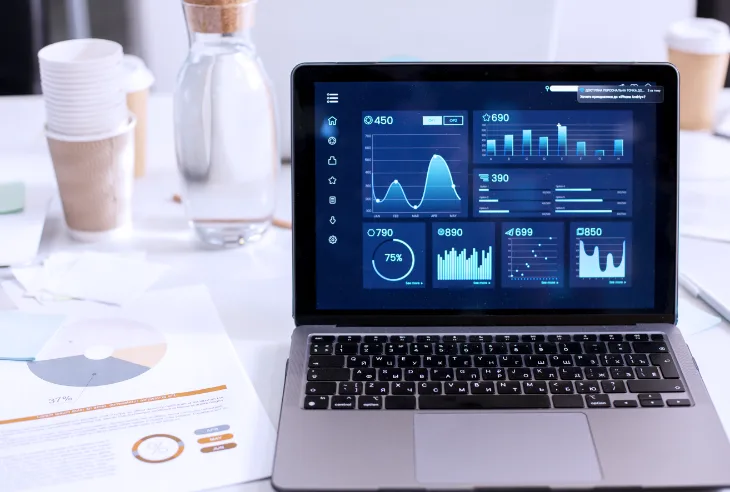Data storytelling with impact: how to create engaging visualizations?

In today’s data-driven landscape, communicating insights effectively is more crucial than ever. Data storytelling through impactful visualizations bridges the gap between raw numbers and actionable understanding. This process transforms complex data into compelling narratives that resonate with audiences and drive decision-making.
According to Study by Tableau, 67% of professionals believe that data storytelling significantly enhances their ability to communicate data and influence decisions. Discover how data storytelling can improve your communication and decision-making.
Understanding how to strategically use data storytelling with visualizations can not only make complex information more digestible but also lead to improved decision-making, increased ROI, and more persuasive communication. Let’s dive into the nuances of creating engaging visualizations that make data come alive.
What are the key benefits of using data storytelling with visualizations?
Data storytelling through visualizations offers numerous advantages for presenting and understanding complex information. By leveraging visual elements to convey data, you can enhance clarity, engagement, and overall effectiveness in communication. Let's explore how data visualizations can transform your approach to presenting information and the substantial benefits they bring to various aspects of decision-making and audience interaction.
Enhanced clarity and understanding
Data visualizations are invaluable for making complex datasets accessible and understandable. By turning raw numbers into visual formats, such as charts and graphs, you simplify the interpretation of data, making it easier for diverse audiences to grasp key insights. This transformation helps bridge the gap between technical data and everyday understanding, ensuring that everyone can follow along regardless of their data expertise.
Improved audience engagement
Engaging visuals are more than just attractive they’re essential for capturing and retaining audience interest. Effective data visualizations grab attention and make information memorable. By presenting data in a visually compelling manner, you enhance its impact and ensure that your audience remains focused on the key messages you want to convey.
Captivating your audience leads directly into the realm of communication, where visualizations can drive meaningful actions and decisions.
Stronger communication and persuasion
Data visualizations are powerful tools for communication, providing a clear and persuasive way to present insights. By crafting a narrative through visuals, you can effectively convey complex information and influence your audience’s perceptions and decisions. This ability to communicate effectively through visuals can significantly enhance the impact of your presentations. The power of visual communication translates into tangible benefits, including improved business outcomes.
Increased ROI
When utilized effectively, data visualizations can lead to better-informed decisions and improved business outcomes. By providing clear, actionable insights, visualizations help stakeholders make more strategic choices, which can result in a higher return on investment (ROI). This improved decision-making process is a direct result of leveraging data-driven insights.
To maximize the benefits of your visualizations, start by identifying the core message you want to convey. Choose the visualization format that best supports this message to ensure clarity and impact.
What are the different types of data visualizations?
Data visualizations come in various forms, each suited for different types of data and analytical needs. Understanding the different types can help you select the right format to effectively communicate your data’s story. These are data visualization types you should know:
- Line graphs: Line graphs are excellent for showcasing trends and changes over time. They allow you to visualize data points connected by lines, providing a clear view of how variables evolve. This type of visualization is particularly useful for tracking changes in metrics such as stock prices or website traffic over a period.
- Bar charts: Bar charts are designed for comparing different categories and highlighting variations in magnitude. They represent data with bars of varying lengths, making it easy to compare metrics such as customer satisfaction across different products or sales figures by region. This format is ideal for visualizing and contrasting categorical data.
- Pie charts: Pie charts are used to display proportions and percentages of a whole. They are effective for showing how different segments contribute to an entire dataset, such as market share among competitors or budget allocations. Each slice of the pie represents a part of the whole, making it easy to understand the distribution of values.
- Scatter plots: Scatter plots are useful for visualizing the relationship between two variables. By plotting data points on a grid, scatter plots can reveal correlations and patterns, such as how customer age correlates with purchase amounts or the impact of advertising spend on website conversion rates.
- Histograms: Histograms are designed to depict the distribution of data points within specific ranges. They are valuable for understanding the frequency and distribution of values, such as income levels or age groups. By grouping data into intervals, histograms offer a clear view of data distribution.
- Heatmaps: Heatmaps use color gradients to represent data across two dimensions, revealing patterns and trends at a glance. They are effective for visualizing data such as customer activity on a website or traffic patterns by location, making it easier to identify areas of interest.
- Area charts:Area charts are similar to line graphs but emphasize the magnitude of changes over time by filling the area beneath the line. They are useful for illustrating cumulative values and trends, such as revenue growth or stock price fluctuations.
- Box plots: Box plots display the distribution of data points, including median, quartiles, and outliers. They are valuable for understanding data spread and variability, such as employee salaries or customer service response times, providing a detailed statistical view.
- Maps: Maps overlay data onto geographical regions, revealing trends and patterns based on location. They are useful for visualizing geographic data, such as sales figures by region or social media sentiment across different areas, providing spatial context to the data.
- Infographics: Infographics integrate various visual elements, such as charts, graphs, and icons, to create a comprehensive and engaging data story. They combine multiple types of visualizations into a cohesive narrative, making them effective for presenting complex information in an accessible format.
 How can to create effective and engaging data visualizations?
How can to create effective and engaging data visualizations?
Creating effective data visualizations involves several key principles and practices to ensure that your visuals are both informative and engaging.
To create impactful data visualizations, you must focus on several core principles that enhance clarity, consistency, and engagement. By adhering to these best practices, you can craft visuals that not only communicate your data effectively but also captivate and hold your audience’s attention.
Keep it simple and clear
Simplicity is essential for effective data visualization. Focus on delivering one key message per visualization to avoid overwhelming your audience with too much information. Clear, uncluttered visuals help viewers quickly grasp the main points without distraction.
Use consistent design elements
Consistency in visual design is crucial for ensuring that your visualizations are easy to interpret and align with your overall style. Use uniform colors, fonts, and layouts to create a cohesive look that supports your message and aids in viewer understanding.
Choose appropriate colors
Colors play a significant role in data visualization by highlighting key data points and creating a visual hierarchy. Use color strategically to draw attention to important elements and ensure that your visuals are both attractive and functional.
Add context and labels
Context and labels are vital for helping viewers interpret your data accurately. Include clear titles, legends, and annotations to provide necessary information and guide your audience through the visual narrative, ensuring that they understand the data being presented.
Leverage storytelling techniques
Data visualizations should not just present information but also tell a story. Use visuals to create a narrative that guides viewers through the data, helping them follow and understand the key points. Effective storytelling through visuals can make your data more engaging and memorable.
Consider your audience
Adapt your visualizations to suit the data literacy and preferences of your target audience. By tailoring the complexity and presentation of your visuals, you ensure that they are accessible and relevant to the people you are addressing.
Utilize data visualization tools
Leverage specialized software and online tools to create high-quality visualizations. These tools provide features and templates that can enhance the design and functionality of your charts and graphs, making it easier to produce professional and effective results.
Regularly test your visualizations with your target audience to ensure that they are clear, engaging, and effective.
What are common mistakes to avoid in data storytelling with visualizations?
Avoiding common pitfalls in data visualization is key to creating effective and credible visual stories. This section outlines frequent mistakes and how to address them to ensure that your visualizations are both accurate and engaging.
Creating effective data visualizations requires careful attention to detail and an understanding of common mistakes that can undermine their effectiveness. By being aware of these pitfalls and how to avoid them, you can enhance the quality of your visual storytelling and ensure that your data is communicated clearly and accurately.
Misusing chart types
Selecting the wrong type of chart for your data can lead to misinterpretation and confusion. Ensure that you choose the most appropriate visualization format for your data to accurately convey the intended message and avoid distorting the information.
Inaccurate or misleading data
Accuracy in data representation is essential for maintaining credibility. Using inaccurate or manipulated data undermines the credibility of your visualizations and can lead to incorrect conclusions. Always ensure that your data is accurate and honestly represented to maintain trust and integrity in your visual storytelling.
Cluttered and unclear design
Cluttered designs can obscure the message; aim for clarity in your visualizations. Overloading visualizations with too much information can make them difficult to understand. Focus on presenting key data points clearly and concisely to avoid confusion and ensure that your audience can easily interpret the visuals.
Lack of context
Providing context enhances understanding and prevents misinterpretation. Without proper context, viewers may misinterpret the data. Ensure that your visualizations include sufficient background information to provide a clear understanding of what the data represents and its significance.
Inconsistent design elements
Consistent design elements contribute to a coherent narrative and effective communication. Inconsistent use of design elements, such as colors and fonts, can disrupt the flow of your visualizations and create confusion. Maintain a consistent visual style to ensure that your visuals are easy to follow and interpret.
Data storytelling: transforming complex data into actionable insights
Data storytelling through impactful visualizations is a powerful method for transforming complex data into clear, engaging, and actionable insights. By understanding the key benefits, exploring various visualization types, and applying best practices in design and execution, you can create visuals that resonate with your audience and drive informed decision-making.
Continue your learning journey by exploring our blog insights for more tips on data solutions and visualization.




 Metam
Metam